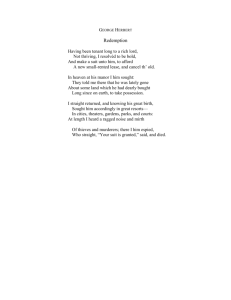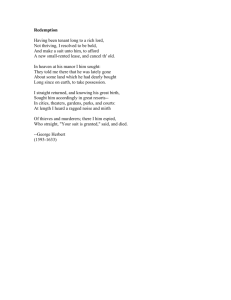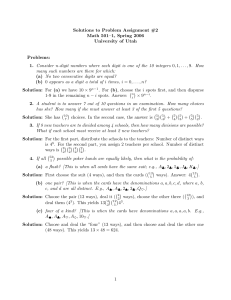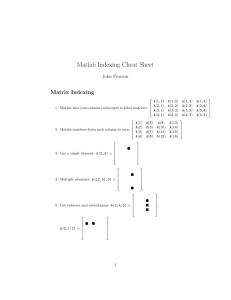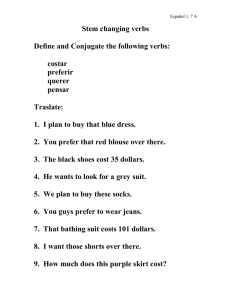A Fast and Optimal Hand Isomorphism Algorithm Kevin Waugh
advertisement
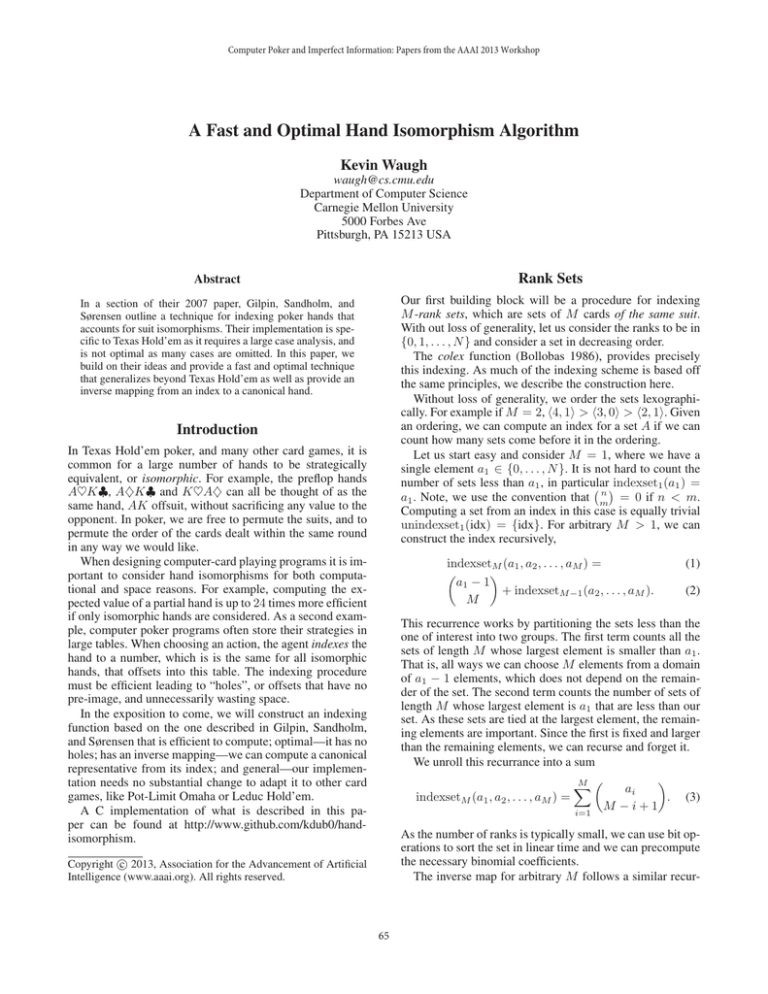
Computer Poker and Imperfect Information: Papers from the AAAI 2013 Workshop
A Fast and Optimal Hand Isomorphism Algorithm
Kevin Waugh
waugh@cs.cmu.edu
Department of Computer Science
Carnegie Mellon University
5000 Forbes Ave
Pittsburgh, PA 15213 USA
Abstract
Rank Sets
In a section of their 2007 paper, Gilpin, Sandholm, and
Sørensen outline a technique for indexing poker hands that
accounts for suit isomorphisms. Their implementation is specific to Texas Hold’em as it requires a large case analysis, and
is not optimal as many cases are omitted. In this paper, we
build on their ideas and provide a fast and optimal technique
that generalizes beyond Texas Hold’em as well as provide an
inverse mapping from an index to a canonical hand.
Our first building block will be a procedure for indexing
M -rank sets, which are sets of M cards of the same suit.
With out loss of generality, let us consider the ranks to be in
{0, 1, . . . , N } and consider a set in decreasing order.
The colex function (Bollobas 1986), provides precisely
this indexing. As much of the indexing scheme is based off
the same principles, we describe the construction here.
Without loss of generality, we order the sets lexographically. For example if M = 2, h4, 1i > h3, 0i > h2, 1i. Given
an ordering, we can compute an index for a set A if we can
count how many sets come before it in the ordering.
Let us start easy and consider M = 1, where we have a
single element a1 ∈ {0, . . . , N }. It is not hard to count the
number of sets less than a1 , in particularindexset1 (a1 ) =
n
a1 . Note, we use the convention that m
= 0 if n < m.
Computing a set from an index in this case is equally trivial
unindexset1 (idx) = {idx}. For arbitrary M > 1, we can
construct the index recursively,
Introduction
In Texas Hold’em poker, and many other card games, it is
common for a large number of hands to be strategically
equivalent, or isomorphic. For example, the preflop hands
A♥K♣, A♦K♣ and K♥A♦ can all be thought of as the
same hand, AK offsuit, without sacrificing any value to the
opponent. In poker, we are free to permute the suits, and to
permute the order of the cards dealt within the same round
in any way we would like.
When designing computer-card playing programs it is important to consider hand isomorphisms for both computational and space reasons. For example, computing the expected value of a partial hand is up to 24 times more efficient
if only isomorphic hands are considered. As a second example, computer poker programs often store their strategies in
large tables. When choosing an action, the agent indexes the
hand to a number, which is is the same for all isomorphic
hands, that offsets into this table. The indexing procedure
must be efficient leading to “holes”, or offsets that have no
pre-image, and unnecessarily wasting space.
In the exposition to come, we will construct an indexing
function based on the one described in Gilpin, Sandholm,
and Sørensen that is efficient to compute; optimal—it has no
holes; has an inverse mapping—we can compute a canonical
representative from its index; and general—our implementation needs no substantial change to adapt it to other card
games, like Pot-Limit Omaha or Leduc Hold’em.
A C implementation of what is described in this paper can be found at http://www.github.com/kdub0/handisomorphism.
indexsetM (a1 , a2 , . . . , aM ) =
a1 − 1
+ indexsetM −1 (a2 , . . . , aM ).
M
(1)
(2)
This recurrence works by partitioning the sets less than the
one of interest into two groups. The first term counts all the
sets of length M whose largest element is smaller than a1 .
That is, all ways we can choose M elements from a domain
of a1 − 1 elements, which does not depend on the remainder of the set. The second term counts the number of sets of
length M whose largest element is a1 that are less than our
set. As these sets are tied at the largest element, the remaining elements are important. Since the first is fixed and larger
than the remaining elements, we can recurse and forget it.
We unroll this recurrance into a sum
M X
ai
indexsetM (a1 , a2 , . . . , aM ) =
. (3)
M −i+1
i=1
As the number of ranks is typically small, we can use bit operations to sort the set in linear time and we can precompute
the necessary binomial coefficients.
The inverse map for arbitrary M follows a similar recur-
c 2013, Association for the Advancement of Artificial
Copyright Intelligence (www.aaai.org). All rights reserved.
65
Algorithm 1 indexgroupM1 ,M2 ,...,MK (A1 , A2 , . . . , AK |U )
sive pattern. In particular,
B ← A1
next ← indexgroupM2 ,...,MK (A2 , . . . , AK |U ∪ A1 )
−|U |
idx ← NM
next
1
for i in 1 to M do
b ← largest(B)
rank ← b − | smaller(b)
∩ U|
idx ← idx + M1rank
+i−1
B ← B \ {b}
end for
return idx
unindexsetM (idx) =
(4)
x−1
{x} ∪ unindexsetM −1 idx −
, where (5)
M
x
x = max x |
≤ idx .
(6)
M
That is, we find the largest element of the set by maximizing
the first term in the original recurrence subject to the constraint that it be less than the provided index.
Computationally, unindexing is more expensive than indexing. In particular, we use a binary search to compute x,
leading to an O(M log N ) procedure as opposed to a very
skinny O(M ). Approximating the binomial coefficients can
reduce the search to no more than a few indices at the cost
of a few floating point operations. For example, using
x k x xe k
≤
≤
(7)
M
M
M
Algorithm 2 unindexgroupM1 ,M2 ,...,MK (idx|U )
−|U |
this ← remainder idx, NM
1
−|U |
next ← bidx/ NM
c
1
B ← unindexsetM1 (idx)
A1 ← ∅
for b ∈ B do
a ← unused-rank(U, b)
A1 ← A1 ∪ {a}
end for
A2 , . . . , AK ← unindexgroupM2 ,...,MK (next|U ∪ A1 )
return A1 , A2 , . . . , AK
we need only search for x in
idx − k + k log k
idx + k log k
exp
≤ x ≤ exp
k
k
(8)
Rank Groups
Our second building block will be a procedure for indexing M1 , M2 , . . . , MK -rank groups. This is a sequence of
K rank sets of the same suit with sizes M1 , M2 , . . . , MK
that do not share cards. Mathematically these operations are
straightforward, but implementing them quickly on a computer is more challenging.
N
First, we note that an M -rank set index has size M
.
This means that we compactly compute an index for the
first set using the method in the previous section. If we recursively compute an index for the remaining M2 , . . . , MK rank group we can combine them as
indexgroupM1 ,M2 ,...,MK (A1 , A2 , . . . , AK ) =
indexsetM1 (A1 )+
N
indexgroupM2 ,...,MK (A2 , . . . , AK |A1 ).
M1
Note that the index size for a group is the multinomial
coefficient
Pi−1
K Y
N − j=1 Mj
size(M1 , M2 , . . . , MK ) =
. (12)
Mi
i=1
Hands
Finally, we are at the stage where we can describe indexing M1 , M2 , . . . , MK -hands, which cannot contain duplicate cards, but can contain all suits. Our first step will be
to compute the group index for each suit using Algorithm 1
and will take a single pass over the cards.
The final concept we will need to create a perfect indexing
is a suit configuration. In particular, a valid suit configuration is a sequence of K numbers for each suit, cj1 , cj2 , . . . , cjK
such that (a) all groups are full—the sum of the counts group
i is Mi , and (b) suit j’s sequence is lexicographically greater
than or equal to that of suit j + 1.
When we have a hand whose suit configuration has no
equal suits, we can deterministically map to a canonical
hand. That is, using a fixed a priori suit ordering, we relabel the suits by their configurations’ lexicographic order
and within a group we sort by suit and then card. The only
added complexity, from a mathematical perspective, comes
when two suits have equal counts in all groups. That is, we
need a way to break ties between suits with the same configuration. We choose to break ties by their groupindex. Note
that two suits can be completely identical and we will account for this when combining the group indices into a final
index.
(9)
(10)
(11)
Second, we note that as A2 cannot share cards with A1 we
are free to rename the ranks in A2 to fit in {0, 1, . . . , N −
M1 }. In particular, we will shift all the ranks above a “used
slot” downward by one. Again, we can do this efficiently
using bit operations. Pseudocode for indexing is shown in
Algorithm 1. Note that we represent the sets as binary numbers where bit i is set if rank i is in our set. As such, ∪ is
logical or, ∩ is logical and, smaller is b − 1, | · | counts the
number of bits set, and largest is the most significant bit. All
of these take a single operation on a modern processor.
To unindex a rank group, we can unindex each rank set
separately and shift the ranks in subsequent rank sets upward. Again, we use bit operations and tabulation to perform the shifting in O(M ) time. Pseudocode for unindexing
is shown in Algorithm 2.
66
Method
Hyperborean
Tartanian
Perfect
Algorithm 3 indexhandC1 ,C2 ,...,CS (idx1 , idx2 , . . . , idxS )
this ← multiset-colexj (idx1 , idx2 , . . . , idxj )
next ← indexhandCj+1 ,...,CS (idxj+1 , . . . , idxS )
return this + size(C1j)+j−1 next
Hyperborean
Tartanian
Perfect
For a fixed suit configuration, to combine the group indices into a single index taking special care when two or
more suits have the same configuration, we will use the
multiset-colex index. The construction of the indexing operator and unindexing operator are exactly the same as for
colex, except we use the fact that the number of multisets
of M elements
drawn from a universe of N elements is
N +M −1
. Note here that N may be large, as it will be the
M
size of the group index for the particular suit configuration
that is replicated, but as M is no bigger than the number of
suits. We can quickly compute this without a table.
Let us demonstrate on a couple of examples. First, an easier case 2♣A♣|6♣J♥K♥. Our first step is to compute the
suit configuration, which is ♣ = h2, 1i > ♥ = h0, 2i >
♠ = ♦ = h0, 0i. Our fixed suit ordering is bridge order, or ♠, ♥, ♦, ♣. In this case we can write down the
canonical hand without first computing the group indices
A♠2♠|6♠K♥J♥. Now, let us compute the group indices
(13)
(14)
(15)
(16)
(17)
13 11
64
2
1
= 55, 218.
This suit configuration has a of size
13
11
2
1
Turn
75,427,404
160,697,537
55,190,538
1.37x
2.91x
1x
1.55x
3.50x
1x
Results
In Table , we show the index sizes for the flop, turn and
river in Texas Hold’em of Hyperborian and Tartanian, along
side our indexing scheme. We see that our scheme provides
a 1.5x improvement over Hyperborian on the river, and a
3.5x improvement over Tartanian. On a Core 2 Duo desktop
machine, we also observed a 3.5x speed up of our indexing
scheme over Hyperborean.
Note that though 6♣ is the 4th rank, we shifted it down by
one as the 2♣ from the previous round is below it. Finally,
we combine theindices
together noting that the size of the
11
first index is 13
2
1 ,
idx = 306 +
1.22x
2.36x
1x
Table 1: Indexing sizes for Texas Hold’em
by computing the group indices:
4
13
4
♣=
+
(20)
1
1
1
= 4 + 13(4) = 56
(21)
8
13
8
♦=
+
(22)
1
1
1
= 8 + 13(8) = 112
(23)
11
♥=0+1
= 11.
(24)
1
Mapping to a canonical hand, we get T ♠6♥|7♠J♥K♦ and
computing the final index
112 + 1
56
156 + 1
idx =
+
+
11
(25)
2
1
2
= [6, 216 + 56] + 12, 246(11) = 140, 078.
(26)
As a final exercise, let us unindex 6, 220 with suit configuration h1, 2i > h1, 1i. First,
12we compute the size of the first
suit configuration as 13
1
2 = 198. This means the group
indices are ♠ = 182 and ♥ = 31, as 182 + 198(31) =
6, 220. Hearts are straightforward to unindex. In particular,
the ranks are 5|2, which map to 7♥|4♥. Spades are slightly
more complicated, the two groups have
indices 0|14. We
need to find the largest x such that x2 ≤ 14, which turns
out to be 5, meaning
the two ranks in the second group are
5, 4. Note 52 + 4 = 14. As the rank from the first group,
0, is less than them both, they must be shifted up by one
before converting to cards. Our final canonical hand is then
2♠7♥|8♠6♠4♥.
The indexing algorithm for a particular suit configuration
is shown in Algorithm 3. We must impose an ordering on the
suit configurations and offset the index we compute based
on this ordering. One can use a hash table, or binary search
to compute this offset. We use a brute force approach and
tabulate from all suit counts to its suit configuration.
12
0
13
3
♣=
+
+
2
1
2
1
= 72 + 78(3) = 306
11
9
♥=0+1
+
2
1
= 55 + 9 = 64
♠ = ♦ = 0.
Flop
1,565,954
3,032,029
1,286,792
River
3,769,937,756
8,516,969,461
2,428,287,420
(18)
References
(19)
Bollobas, B. 1986. Combinatorics. Cambridge University
Press.
Gilpin, A.; Sandholm, T.; and Sørensen, T. 2007. Potentialaware automated abstraction of sequential games, and holistic equilibrium analysis in Texas Hold’em poker. In Twenty
Second National Conference on Artificial Intelligence.
13
2 .
Let us now consider a harder example, where two suits
have the same configuration, 6♦T ♣|J♣7♦K♥. We see that
♦ = ♣ = h1, 1i > ♥ = h0, 1i > ♠ = h0, 0i, so let us start
67


